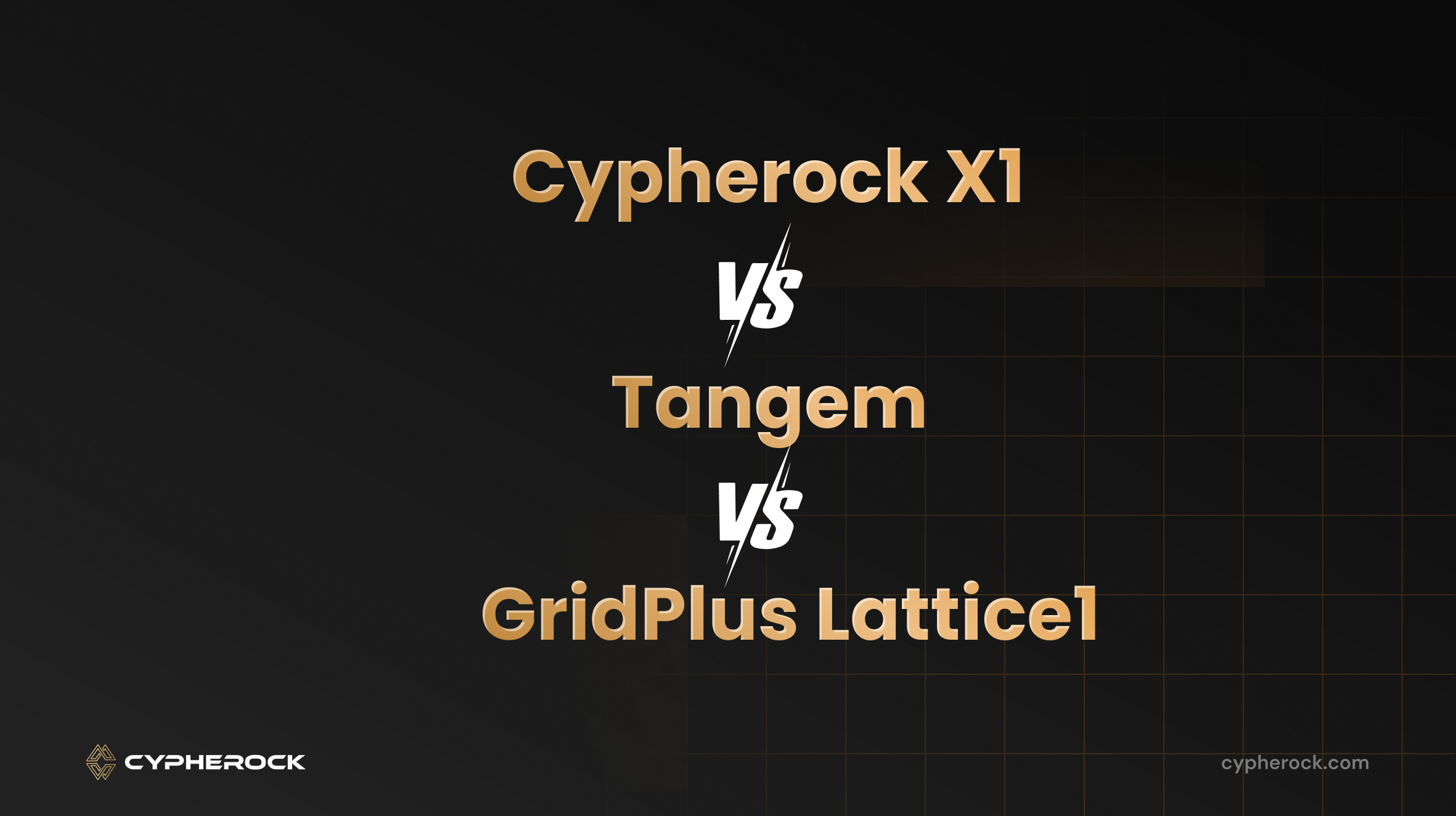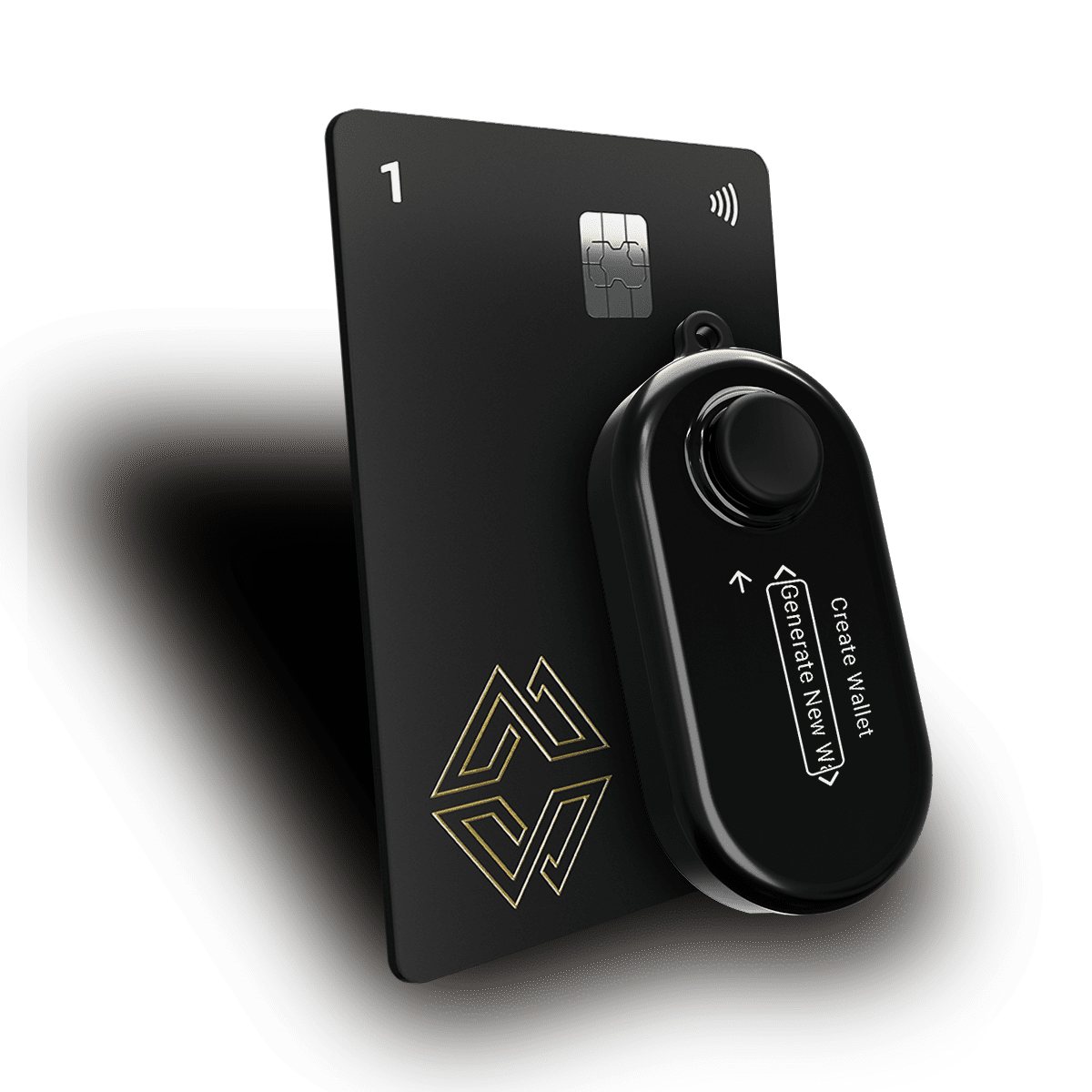

In the world of cryptocurrency, security is paramount. As the value of digital assets grows, so does the need for secure storage solutions. Hardware wallets have become a popular choice for protecting crypto investments from online threats, but not all hardware wallets are created equal. In this article, we’ll compare three leading hardware wallets, Tangem, GridPlus Lattice1, and Cypherock X1, to help you choose the best one for your needs.
Each of these wallets offers a unique approach to crypto storage, from Tangem’s simple card-based design to Cypherock’s cutting-edge, decentralized key storage system. Whether you’re a beginner looking for ease of use or an advanced user seeking maximum security, this head-to-head comparison will break down the key features, security protocols, and usability of each wallet. Let's dive into the details and find out which one suits you best.
The Cypherock X1 uses a multi-component system that is designed for high security. It does not rely on the typical seed phrase backup used by most hardware wallets. Instead, it uses a technique called Shamir Secret Sharing to split the private key into five parts, with two needed to restore your wallet. This decentralized storage approach removes the single point of failure risk. The Cypherock X1 consists of the X1 Vault and four X1 cards, each securely storing a part of your private key. This setup ensures that even if one part of the system is lost or compromised, your funds remain safe.
Tangem offers a radically different design compared to most hardware wallets. Its main selling point is its card-shaped design, which resembles a standard bank card. This NFC-enabled wallet allows you to perform transactions by simply tapping it against your phone, removing the need for cables or recovery seed phrases. While this card-based design is sleek and compact, it may feel less secure for users who are used to traditional hardware wallets. Tangem relies on physical security, with the private keys being generated and stored directly on the card. However, if you lose the card, you lose access to your funds unless you've opted for the optional recovery phrase.
The Lattice1 is a high-end hardware wallet that functions similarly to a point-of-sale terminal. It features a large touchscreen display, making it easy to manage multiple accounts and transactions. The Lattice1 supports SafeCards, which are used to back up cryptocurrency accounts. This wallet allows for seamless transactions and portfolio management. However, its large size and constant power requirement make it less portable than other wallets, which might be a drawback for users on the go.
The Cypherock X1 offers some of the highest security features available in a hardware wallet. By splitting your private key into five parts using Shamir Secret Sharing, it removes the traditional seed phrase vulnerability. The device uses EAL6+ certified chips for secure key storage. Additionally, it supports geographically distributed backup through its X1 cards, which can be stored in multiple locations. This approach provides extra security in case of theft, loss, or natural disasters.
Tangem focuses on physical security with its card-based wallet design. The private keys are securely stored on the NFC-enabled cards and never leave the device, making it more secure than software wallets that store keys online. It uses EAL6+ certified chips, ensuring that the card is resistant to physical tampering and is highly secure against unauthorized access. The lack of a recovery phrase makes it less prone to the typical vulnerabilities that other hardware wallets face. However, if you lose the Tangem card and haven't set up a recovery phrase, you may not be able to recover your funds.
The Lattice1 is built for high-volume traders, with a focus on enterprise-level security. It features a Secure Enclave and CLDS Tamper Detection Mesh to ensure that private keys are protected from physical tampering and external probing. The Lattice1 also supports PIN protection and SafeCard backups, which adds an additional layer of security. Its offline storage ensures that private keys are never exposed to the internet, keeping them safe from remote attacks. However, because it needs to remain constantly plugged in, the device is less portable and may be vulnerable if compromised by physical access.
Unlike traditional wallets that rely on seed phrases, Cypherock eliminates this risk entirely by using Shamir Secret Sharing to split the private key into multiple pieces. Users must store two of the five parts to restore access to their funds. This unique design mitigates the risks associated with seed phrase backup, such as loss, theft, or damage. However, the backup process is slightly more complex than standard seed phrase storage, and users must take care to keep their backup cards safe.
Tangem does not use a traditional seed phrase. Instead, the private key is stored directly on the NFC-enabled card. While this design simplifies the backup process and eliminates the risk of seed phrase loss, it also introduces risks if the card is lost or damaged. Tangem offers the option to create a recovery phrase for users who want an additional layer of backup. However, this option is not mandatory, and many users may prefer the simplicity of not having to worry about recovery phrases.
The Lattice1 uses a more traditional approach to backup and recovery. Users are provided with a 24-word recovery phrase during setup. This phrase must be written down and securely stored, as losing it means losing access to the wallet. Additionally, the Lattice1 supports SafeCard backups, which can store encrypted backups of users' cryptocurrency accounts. These cards can be used to restore the wallet if the device is lost or damaged. However, this system still relies on the standard recovery phrase, which may be a concern for some users who prefer a more secure, decentralized backup method.
The Cypherock X1 is designed with both security and ease of use in mind. The X1 Vault is equipped with an OLED display and a 5-way joystick, allowing users to easily navigate through the interface and confirm transactions. Transactions are authorized by tapping one of the X1 cards on the Vault, simplifying the process while maintaining high security. The Cypherock system is also user-friendly, with a desktop and mobile app that provides seamless portfolio management and wallet synchronization.
Tangem is one of the easiest wallets to use due to its tap-and-go design. The wallet communicates with your phone via NFC, making it incredibly simple to check your balance, send, and receive funds. The Tangem app is intuitive and easy to navigate, offering a streamlined experience for beginners. However, the lack of a built-in screen on the card means that users must rely on their mobile devices for transaction verification, which may be a concern for some users who prefer an all-in-one device.
The Lattice1 is designed for users who need to manage multiple wallets or accounts. It features a large 5-inch touchscreen, which allows users to navigate through the wallet and confirm transactions with ease. The interface is straightforward, and the device supports MetaMask integration, making it an excellent choice for Web3 and DeFi users. However, the large size of the Lattice1 makes it less portable, and its reliance on a constant power source can be a drawback for users who need a more mobile solution.
Cypherock X1 is an open-source hardware wallet, meaning that its software can be independently reviewed and audited by the community. This transparency is crucial for users who want to ensure that there are no hidden vulnerabilities or backdoors in the wallet’s firmware. The open-source nature of the X1 also contributes to its overall security, as any issues are likely to be quickly identified and addressed.
Tangem is closed-source, meaning that users cannot independently verify the wallet’s firmware. However, the wallet has undergone independent security audits, and the company claims that the firmware is free from backdoors and vulnerabilities. While this approach may be acceptable to some users, others may prefer the transparency that open-source wallets provide.
GridPlus also follows an open-source approach for its firmware, which enhances transparency and security. The Lattice1’s firmware has been independently audited, and the company maintains a commitment to ensuring that there are no hidden vulnerabilities. As with the Cypherock X1, this open-source nature allows the community to verify the security of the device, which can provide peace of mind to users.
Cypherock X1 supports a wide range of cryptocurrencies, including Bitcoin, Ethereum, Solana, and many others. The wallet is designed to handle over 9,000 cryptocurrencies, making it an excellent choice for users who need a wallet that can manage a large and diverse portfolio. Additionally, the X1 is compatible with decentralized finance (DeFi) applications through WalletConnect.
Tangem supports a limited number of cryptocurrencies compared to the Cypherock X1. However, it does support major coins like Bitcoin and Ethereum, as well as a variety of ERC-20 tokens. While it may not support as many assets as some other wallets, Tangem's simplicity and ease of use make it an excellent choice for users who only need to store a few major cryptocurrencies.
The Lattice1 supports a broad range of cryptocurrencies, including Bitcoin, Ethereum, Polygon, and Binance Smart Chain. It also supports ERC-20 tokens and NFTs on Ethereum and Polygon. The Lattice1 is particularly suited for users who are heavily involved in Web3 and decentralized finance (DeFi), as it integrates seamlessly with MetaMask and other DeFi platforms.
The Cypherock X1 combined with the CySync app is a game-changer for managing your assets. The app’s not only available on desktop, Android, and iOS, but it also allows you to seamlessly manage multiple portfolios, track your holdings, and perform secure transactions with ease. Plus, the backup and recovery options make it simple to protect your assets, all without worrying about seed phrases.
Tangem’s companion app is available for both Android and iOS. It’s simple to use and allows users to manage their Tangem card and perform transactions with ease. The app also supports WalletConnect, making it compatible with a variety of DeFi and DApp platforms. However, the app lacks some advanced features that other wallets may offer.
GridPlus offers a seamless integration with multiple wallets, including MetaMask and Rabby. The Lattice1’s companion app allows users to manage their portfolios, sign transactions, and interact with DeFi platforms. The app is compatible with both desktop and mobile, and the large screen on the Lattice1 provides an intuitive interface for managing assets.
Cypherock X1 supports multiple wallets, allowing users to store up to four different wallets on a single device. This feature is particularly useful for users who want to manage both personal and business funds separately. Additionally, the inheritance feature allows users to pass on their crypto assets to loved ones in the event of their death.
Tangem supports single-wallet usage, but users can store multiple Tangem cards if they wish to manage different accounts. However, the lack of multi-wallet support may be a limitation for more advanced users who need to manage a diverse portfolio across several wallets.
The Lattice1 allows users to manage multiple accounts via its SafeCard backups. This feature is ideal for users who have large portfolios and need to track assets across several wallets. However, users must rely on Seed phrases and PIN codes to manage their backups securely.
Pros:
Cons:
Pros:
Cons:
Pros:
Cons:
Choosing between Tangem, Cypherock X1, and GridPlus Lattice1 depends on your needs and preferences. If you prioritize security and the ability to manage multiple wallets, Cypherock X1 is a strong contender. For users who want a simple, mobile solution and are comfortable with NFC technology, Tangem is an excellent choice. If you're an active trader or need a wallet with advanced features, the GridPlus Lattice1 offers high security and ease of use but comes at a premium price.
Start securing your crypto journey today—visit Cypherock X1 to learn more.
Connect with us:
Twitter: @CypherockWallet
Telegram: Join the Community
